Enhanced Ventilation and Energy Efficiency of an Optimized Double-Channel Solar Chimney
Abstract
:1. Introduction
2. Numerical Simulation
2.1. Physical Models for Numerical Simulations
2.2. Simulation Condition Setting
- (1)
- The air is an ideal incompressible gas, usually using the Boussinesq assumption;
- (2)
- The physical properties of the air inside the solar wall chimney are constant, and the air density is the only variable;
- (3)
- The viscous dissipation of air in the flow channel can be ignored;
- (4)
- The shell’s heat transfer loss and the outer wall’s radiant heat loss can be ignored.
2.3. Control Equations and Calculation Methods
2.4. Boundary Condition Settings
2.5. Grid Independence Verification
3. Experimental Measurement
3.1. Experimental Subject and Testing Instruments
3.2. Experimental Details
3.3. Verification of Results
4. Results and Discussion
4.1. Effect of Deflector Length on Chimney Ventilation Performance
4.1.1. Impact on Ventilation Rate
4.1.2. Impact on Thermal Efficiency
4.1.3. Analysis of Vortex Area in the Chimney
4.2. Influence of Deflector Angle on Chimney Ventilation Performance
4.2.1. Impact on Ventilation Rate
4.2.2. Impact on Thermal Efficiency
4.2.3. Analysis of Vortex Area in the Chimney
4.3. Conditions for the Ventilation Performance of the Optimized Double-Channel Solar Chimney
4.4. Energy-Saving Potential of the Optimized Double-Channel Solar Chimney
5. Conclusions
- Numerical simulations revealed that the ventilation performance of double-channel solar chimneys exhibits a non-monotonic trend with increasing deflector length (l/D), characterized by an initial enhancement followed by a decline. An appropriately sized deflector can optimize the streamlined structure, preventing vortices caused by sudden changes in cross-section. However, an excessively long deflector may increase local energy loss. The optimal performance was achieved when the deflector length reached l/D = 0.3. At this configuration, the ventilation rate increased by 5.59% and the thermal efficiency improved by 3.8% compared with the baseline design (without deflectors).
- The deflector inclination angle relative to the horizontal plane critically determines system performance. Empirical results demonstrate that deflector angles within 30° ≤ γ ≤ 80° universally enhance ventilation performance compared with conventional dual-channel solar chimneys. A properly angled deflector can precisely direct the airflow, preventing turbulence or recirculation zones, thereby improving the uniformity of airflow distribution. The γ = 35° configuration achieved peak optimization with improvements of 6.8% and 4.4%, respectively, over baseline values.
- The optimal installation conditions for the deflector in the optimized double-channel solar chimney are a deflector angle to the horizontal of γ = 35° and a length-to-diameter ratio l/D = 0.3. These conditions were applied in the building ventilation simulations, and at all times during operation, the ventilation performance of the optimized double-channel solar chimney was significantly better than that of the traditional solar chimney. Particularly at 13:00, under peak solar irradiance (800 W/m2), the ventilation rate of the optimized double-channel solar chimney reached up to 0.185 kg/s, an 8.8% improvement compared with the unoptimized conditions. The thermal efficiency reached 40.2%, an increase of 6.08%.
- The building’s total annual energy consumption with the application of the optimized double-channel solar chimney was reduced by 13.6% compared with conventional designs. The energy-saving potential of the optimized double-channel solar chimney is especially significant during transitional seasons, with energy-saving rates reaching as high as 60.9% in May and 51.9% in October.
Author Contributions
Funding
Data Availability Statement
Conflicts of Interest
Nomenclature
| Turbulent pulsation kinetic energy (J) | |
| Fluid effective dynamic viscosity kg/(s·m) | |
| Air density (kg/m3) | |
| Dissipation rate of turbulent pulsating momentum | |
| Reciprocal of the effective Prandtl number ε | |
| Velocity of fluid in the x direction (m/s) | |
| Velocity of fluid in the y direction (m/s) | |
| Velocity of fluid in the z direction (m/s) | |
| Initial temperature (K) | |
| Calculation constant | |
| Calculation constant | |
| Turbulent kinetic energy due to mean velocity gradient (J) | |
| γ | Deflector angle (°) |
| l | Length of deflector (m) |
| D | Depth of solar chimney (m) |
| H | Height of solar chimney (m) |
| L | Width of solar chimney (m) |
| l1 | Length of solar collector (m) |
| L1 | Width of solar collector (m) |
References
- Liu, Z.; Zhang, L.; Gong, G.; Li, H.; Tang, G. Review of solar thermoelectric cooling technologies for use in zero energy buildings. Energy Build. 2015, 102, 207–216. [Google Scholar] [CrossRef]
- Lotfabadi, P. Analyzing passive solar strategies in the case of high-rise building. Renew. Sustain. Energy Rev. 2015, 52, 1340–1353. [Google Scholar] [CrossRef]
- Fang, X.; Li, Y. Numerical simulation and sensitivity analysis of lattice passive solar heating walls. Sol. Energy 2000, 69, 55–66. [Google Scholar] [CrossRef]
- Zhai, X.; Song, Z.; Wang, R. A review for the applications of solar chimneys in buildings. Renew. Sustain. Energy Rev. 2011, 15, 3757–3767. [Google Scholar] [CrossRef]
- Khedari, J.; Rachapradit, N.; Hirunlabh, J. Field study of performance of solar chimney with air-conditioned building. Energy 2003, 28, 1099–1114. [Google Scholar] [CrossRef]
- Agarwal, S.; Batista, R. Enhancement of building thermal performance: A comparative analysis of integrated solar chimney and geothermal systems. J. Sustain. Energy 2023, 2, 91–108. [Google Scholar] [CrossRef]
- Shi, L.; Zhang, G.; Yang, W.; Huang, D.; Cheng, X.; Setunge, S. Determining the influencing factors on the performance of solar chimney in buildings. Renew. Sustain. Energy Rev. 2018, 88, 223–238. [Google Scholar] [CrossRef]
- Hosien, M.; Selim, S. Effects of the geometrical and operational parameters and alternative outer cover materials on the performance of solar chimney used for natural ventilation. Energy Build. 2017, 138, 355–367. [Google Scholar] [CrossRef]
- Xu, X.W.; Su, Y.X. Modeling of natural ventilation in built-in photovoltaic-Trombe wall. Appl. Mech. Mater. 2014, 448, 1537–1541. [Google Scholar] [CrossRef]
- Zalewski, L.; Lassue, S.; Duthoit, B.; Butez, M. Study of solar walls—Validating a simulation model. Build. Environ. 2002, 37, 109–121. [Google Scholar] [CrossRef]
- Lee, K.H.; Strand, R.K. Enhancement of natural ventilation in buildings using a thermal chimney. Energy Build. 2009, 41, 615–621. [Google Scholar] [CrossRef]
- Zhang, L.; Dong, J.; Sun, S.; Chen, Z. Numerical simulation and sensitivity analysis on an improved Trombe wall. Sustain. Energy Technol. Assess. 2021, 43, 100941. [Google Scholar] [CrossRef]
- Imran, A.A.; Jalil, J.M.; Ahmed, S.T. Induced flow for ventilation and cooling by a solar chimney. Renew. Energy 2015, 78, 236–244. [Google Scholar] [CrossRef]
- Bassiouny, R.; Koura, N.S. An analytical and numerical study of solar chimney use for room natural ventilation. Energy Build. 2008, 40, 865–873. [Google Scholar] [CrossRef]
- Han, M.; Cui, H.; Han, Z.; Liu, Q. Research on the new passive optimization strategies for improving the performance of combined solar chimney. Energy Build. 2024, 320, 114578. [Google Scholar] [CrossRef]
- Arce, J.; Xamán, J.; Alvarez, G.; Jiménez, M.; Guzmán, J.; Heras, M. Theoretical study on a diurnal solar chimney with double air flow. In Proceedings of the 1st International Conference on Solar Heating, Cooling and Buildings (EUROSUN), Sociedade Portuguesa de Energia Solar (SPES), Lisbon, Portugal, 7–10 October 2008; pp. 7–10. [Google Scholar]
- Vargas-López, R.; Xamán, J.; Hernández-Pérez, I.; Arce, J.; Zavala-Guillén, I.; Jiménez, M.; Heras, M. Mathematical models of solar chimneys with a phase change material for ventilation of buildings: A review using global energy balance. Energy 2019, 170, 683–708. [Google Scholar] [CrossRef]
- Zavala-Guillén, I.; Xamán, J.; Álvarez, G.; Arce, J.; Hernández-Pérez, I.; Gijón-Rivera, M. Computational fluid dynamics for modeling the turbulent natural convection in a double air-channel solar chimney system. Int. J. Mod. Phys. C 2016, 27, 1650095. [Google Scholar] [CrossRef]
- Lei, Y.; Zhang, Y.; Wang, F.; Wang, X. Enhancement of natural ventilation of a novel roof solar chimney with perforated absorber plate for building energy conservation. Appl. Therm. Eng. 2016, 107, 653–661. [Google Scholar] [CrossRef]
- Fang, Z.; Wang, W.; Chen, Y.; Song, J. Structural and heat transfer model analysis of wall-mounted solar chimney inlets and outlets in single-story buildings. Buildings 2022, 12, 1790. [Google Scholar] [CrossRef]
- Gowda, B.K.; Rajagopal, M.; Seetharamu, K. Heat transfer in a side heated trapezoidal cavity with openings. Eng. Sci. Technol. Int. J. 2019, 22, 153–167. [Google Scholar] [CrossRef]
- Zhou, Y.; Wang, Z.; Xu, L.; Zhang, S.; Sui, C. Characteristic analysis of buoyancy induced indoor ventilation in Trombe wall channels. Acta Energiae Solaris Sin. 2021, 42, 176–183. [Google Scholar]
- Mandal, D.K.; Pradhan, S.; Chakraborty, R.; Barman, A.; Biswas, N. Experimental investigation of a solar chimney power plant and its numerical verification of thermo-physical flow parameters for performance enhancement. Sustain. Energy Technol. Assess. 2022, 50, 101786. [Google Scholar]
- Sheng, Z.; Zhang, G.; Luo, X.; Ye, C.; Lin, J.; Chen, Z. Research Optimizing Building Ventilation Performance through the Application of Trombe Walls in Regions with Hot Summers and Cold Winters: A Case Study in China. Sustainability 2024, 16, 3107. [Google Scholar] [CrossRef]
- Gong, J.; Cheng, K.X.; Liu, H.; Chew, L.W.; Lee, P.S. A novel staggered split absorber design for enhanced solar chimney performance. Build. Environ. 2022, 224, 109569. [Google Scholar] [CrossRef]
- Omle, I.; Kovács, E.; Bolló, B. Applying recent efficient numerical methods for long-term simulations of heat transfer in walls to optimize thermal insulation. Results Eng. 2023, 20, 101476. [Google Scholar] [CrossRef]
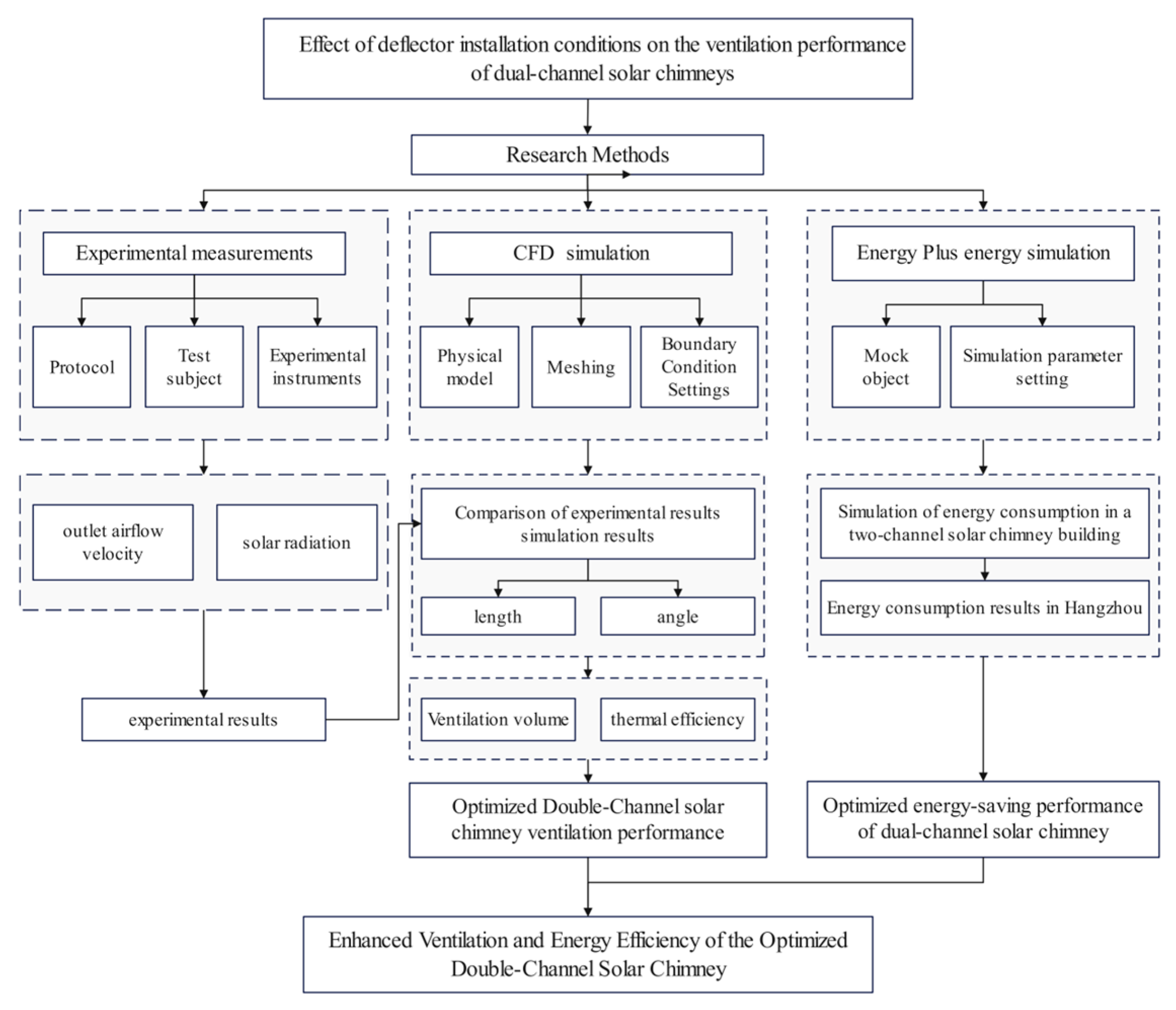


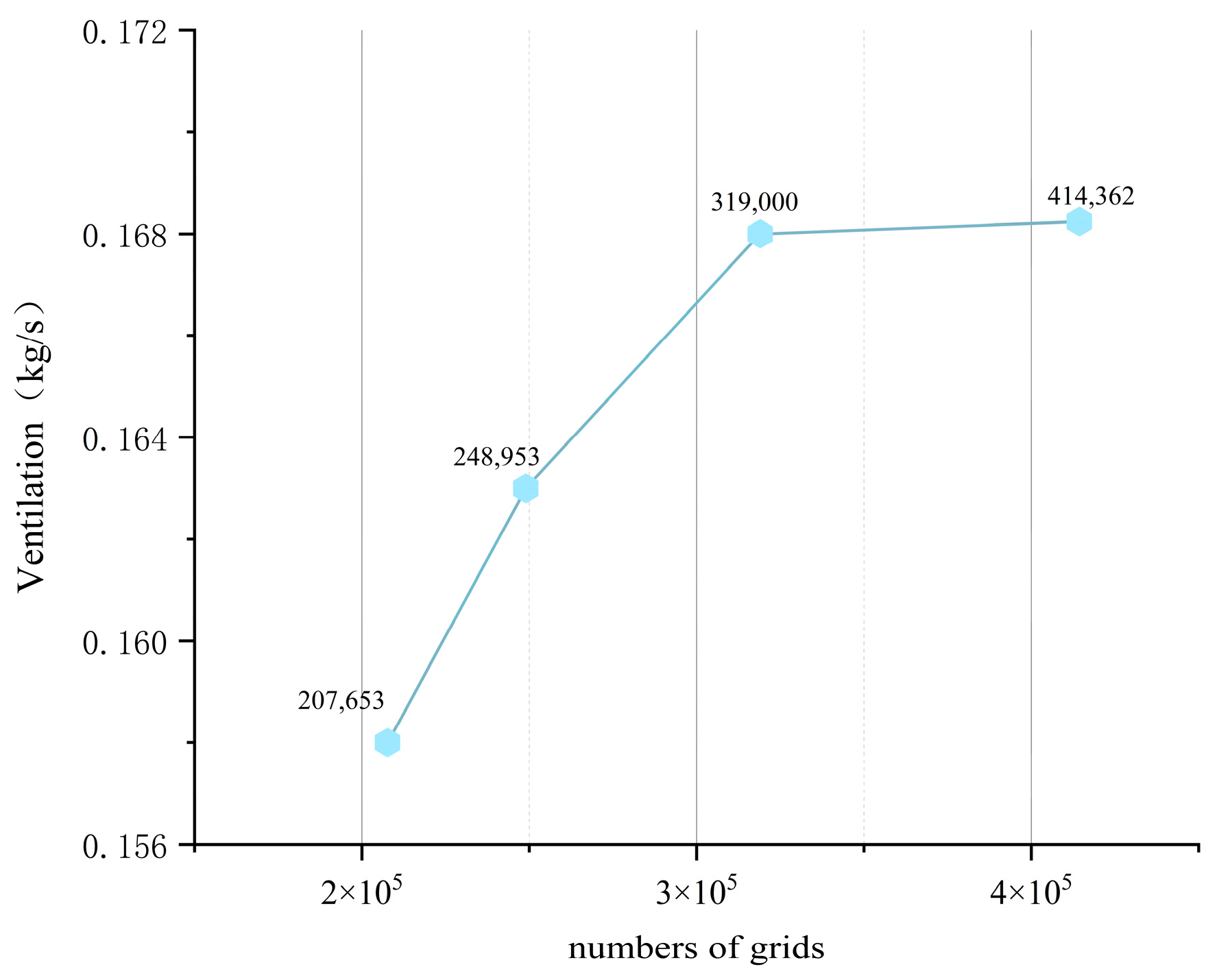


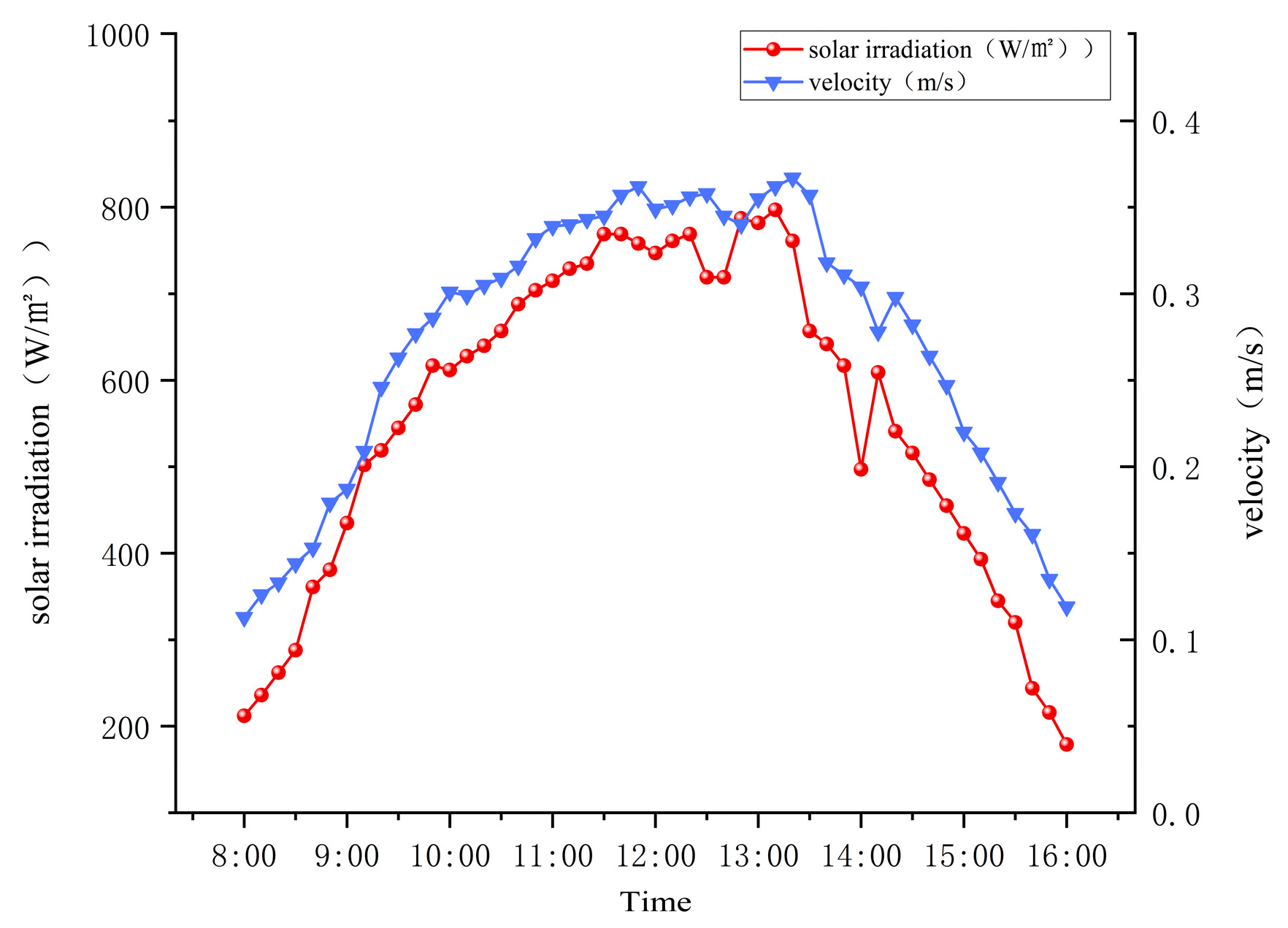

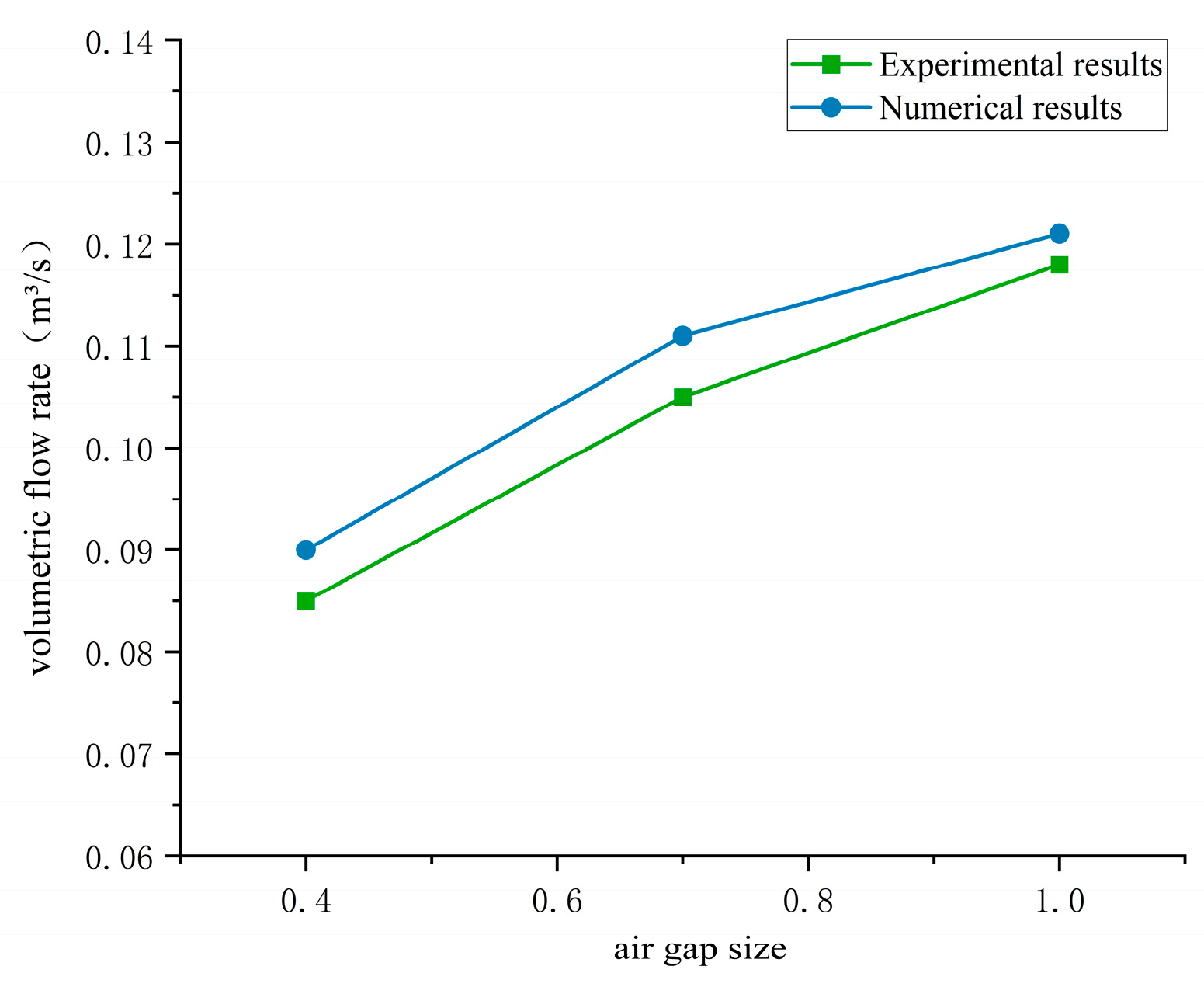





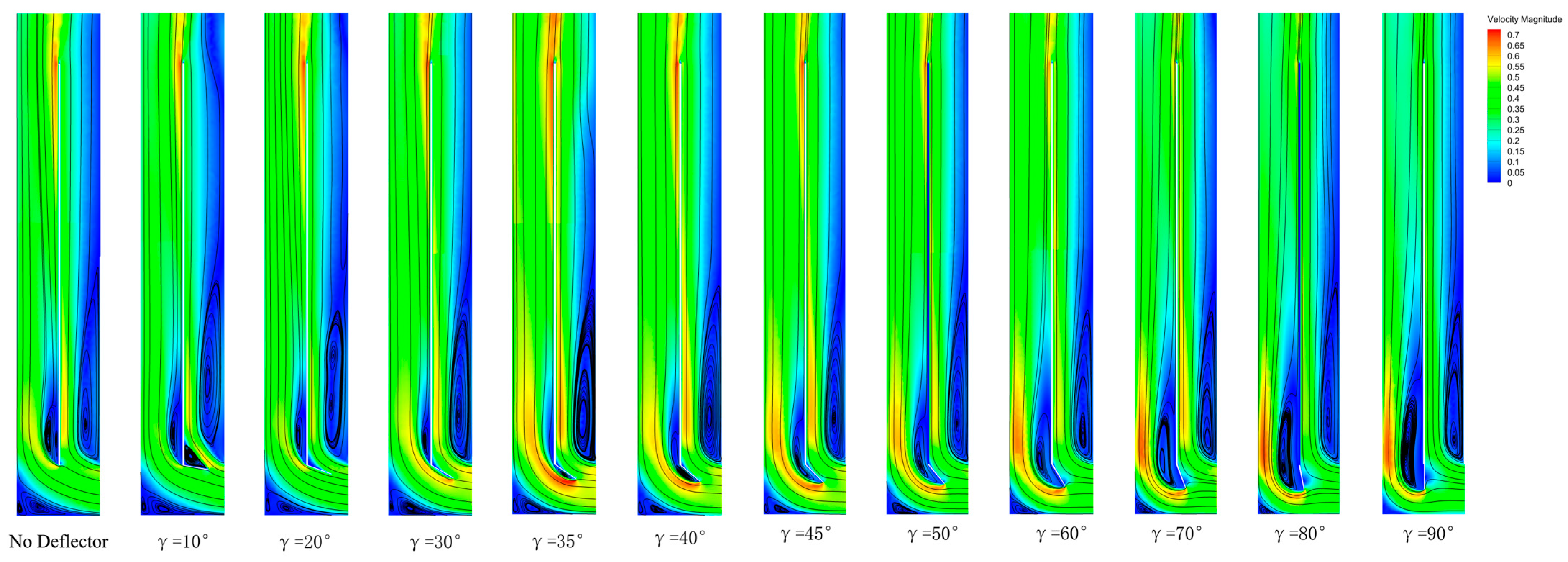
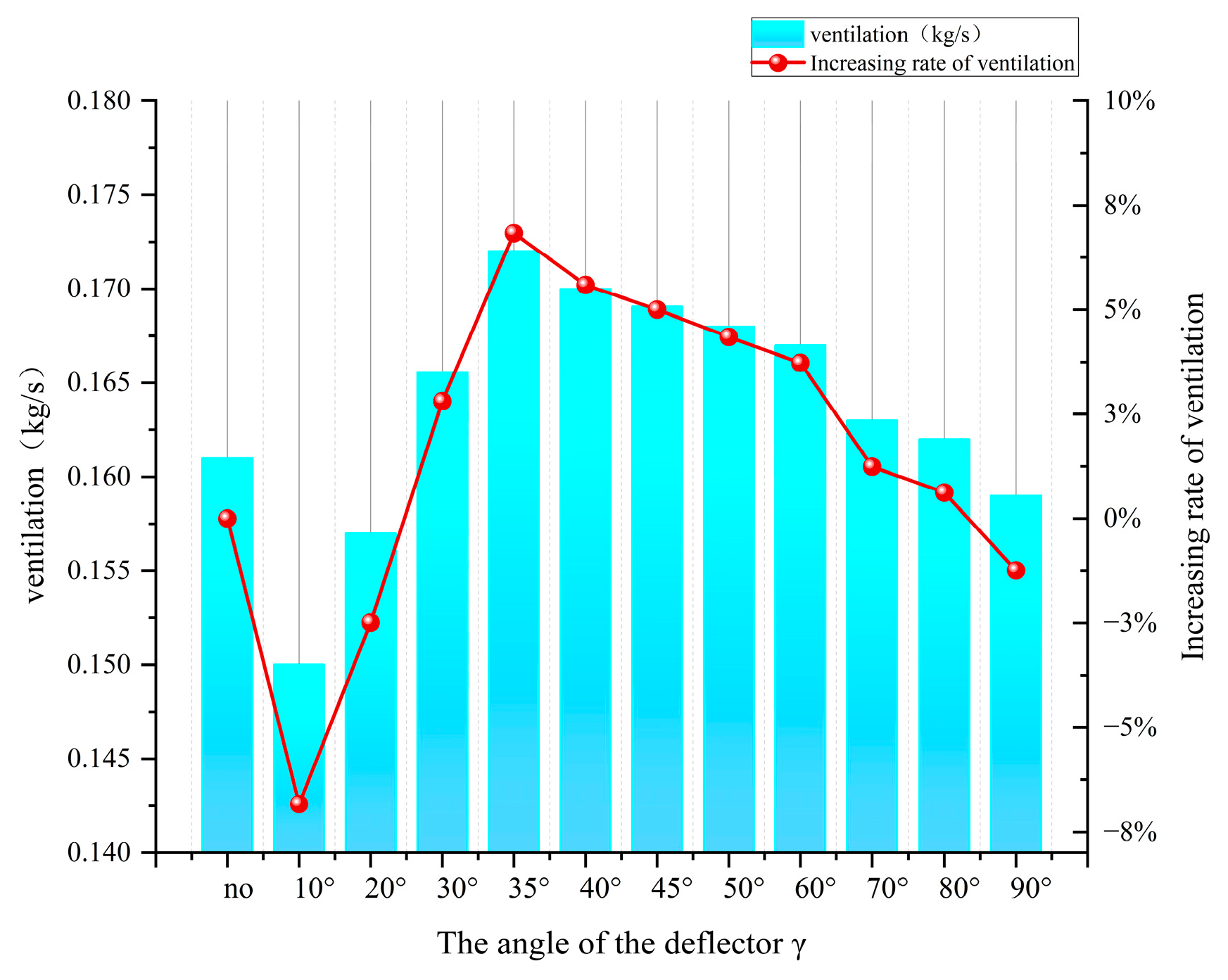


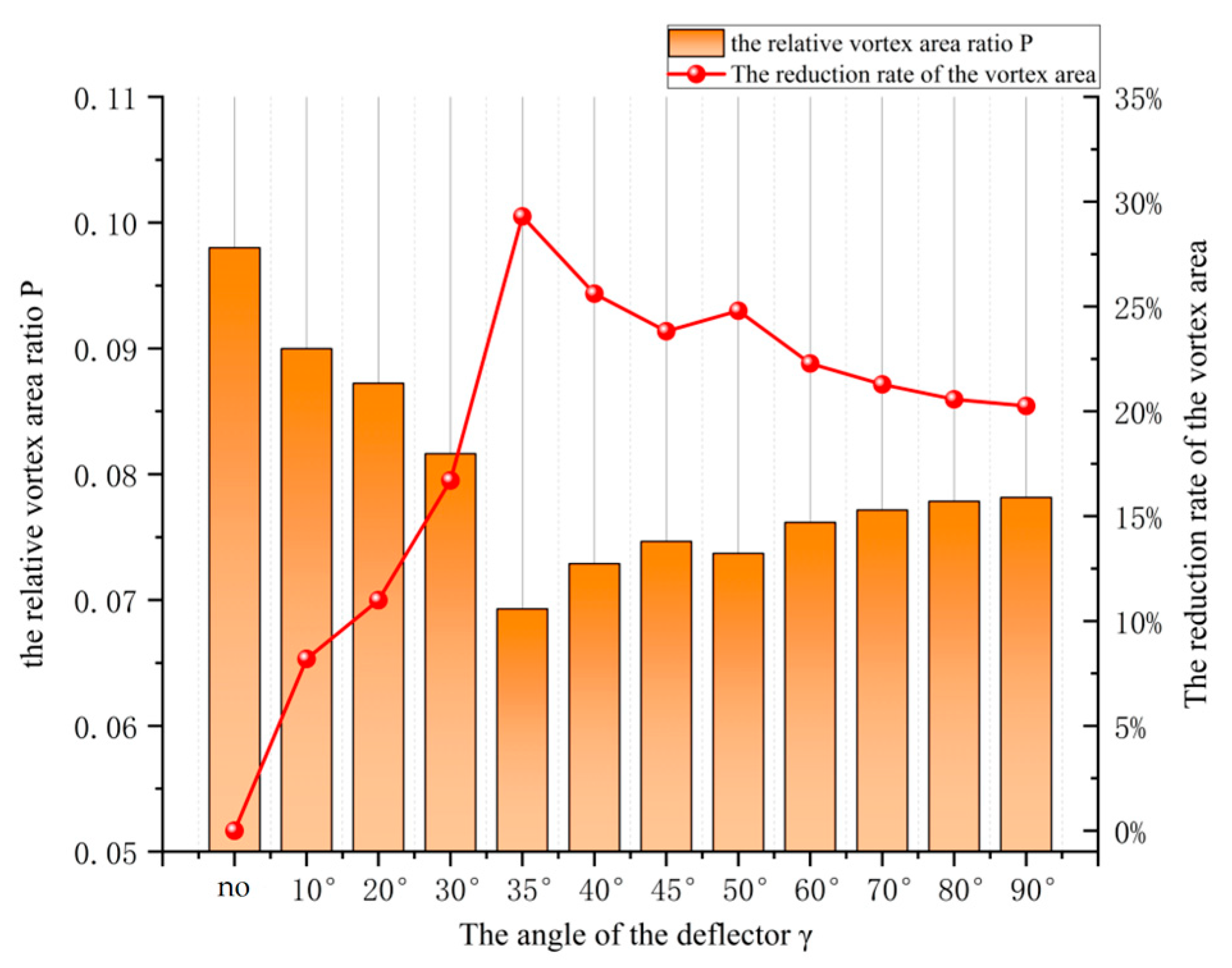


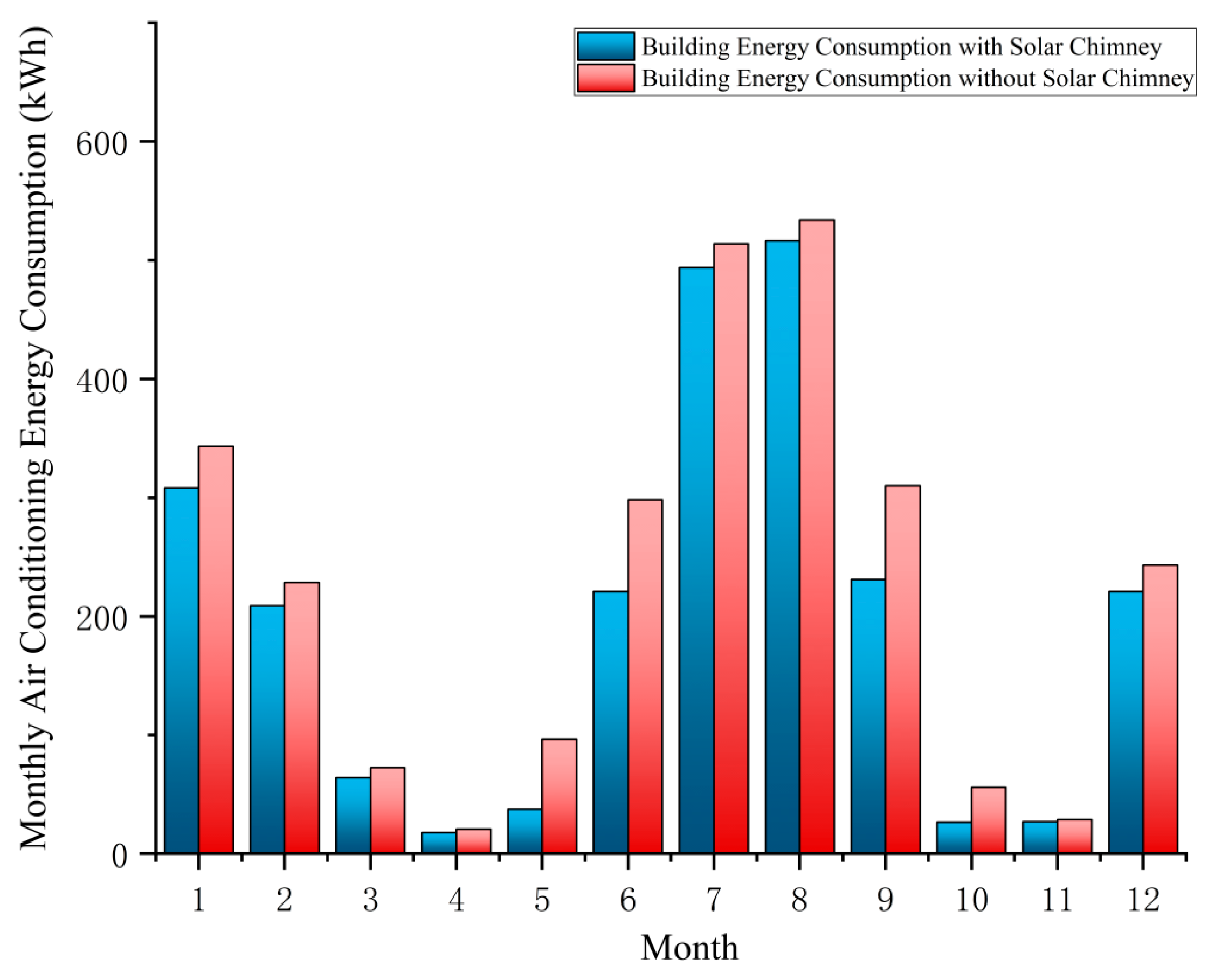
| Name | Density (kg/m3) | Specific Heat (J/(kg∙K)) | Thermal Conductivity (W/(m∙K)) | Absorption | Transmittance | Material |
|---|---|---|---|---|---|---|
| Window | 2500 | 840 | 0.75 | 0.06 | 0.84 | Glass |
| Insulation wall | 1800 | 879 | 0.814 | / | / | Concrete |
| Solar collector | 2719 | 871 | 202.4 | 0.95 | / | Aluminum alloy |
| Density (kg/m3) | Specific Heat (J/(kg∙K)) | Thermal Conductivity (W/(m∙K)) | Viscosity Coefficient (kg/(m∙s)) | Coefficient of Thermal Expansion(1/K) |
|---|---|---|---|---|
| 1.205 | 1005.43 | 0.259 | 1.81 × 10−5 | 0.0034 |
| Instrument Name and Model | Measured Parameters | Instrument Accuracy and Testing Range |
|---|---|---|
| Ruiyika solar pyranometer (China) | Solar radiation on the solar chimney | Spectral range: 300–3200 nm; Measurement range: 0–2000 W/m2; Response time: ≤20 s (99% response); Internal resistance:350 Ω; Cosine response: ≤±7% (at solar altitude angle = 10°); Temperature dependence: ±2% (−10 + 40 °C); Sensitivity: 7–14 μV·W⁻1·m2; Nonlinearity: ±2%; Measurement accuracy: ≤5%. |
| Biaozhi GM8903 thermal anemometer (China) | Airflow velocity at the outlet measurement points | Wind speed measurement range: 0–30 m/s; Resolution: 0.001 m/s; Accuracy: ±3%. |
| Aluminum alloy sheet | / | 400 mm × 800 mm × 3 mm |
| Plywood panel | / | 1000 mm × 300 mm × 2 mm × 2; 400 mm × 300 mm × 2 mm; 400 mm × 900 mm × 2 mm |
| Acrylic panel | / | 1000 mm × 400 mm × 2 mm; Transmittance: 92% |
| Month | AC Energy (No Solar Chimney) (kWh) | AC Energy (with Solar Chimney) (kWh) | Energy Saved (kWh) | Efficiency Gain (%) |
|---|---|---|---|---|
| January | 343.4 | 308.3 | 35.1 | 10.2 |
| February | 228.4 | 208.8 | 19.6 | 8.5 |
| March | 72.7 | 63.9 | 8.8 | 12.1 |
| April | 20.8 | 17.9 | 2.9 | 13.9 |
| May | 96.5 | 37.7 | 58.8 | 60.9 |
| June | 298.4 | 220.7 | 77.7 | 26 |
| July | 513.9 | 493.8 | 20.1 | 3.9 |
| August | 533.7 | 516.5 | 17.2 | 3.2 |
| September | 310 | 231.1 | 78.9 | 25.4 |
| October | 55.7 | 26.8 | 28.9 | 51.9 |
| November | 28.8 | 22.1 | 6.7 | 23.2 |
| December | 243.3 | 220.7 | 22.6 | 9.2 |
| Year | 2745.6 | 2373.3 | 372.3 | 13.6 |
Disclaimer/Publisher’s Note: The statements, opinions and data contained in all publications are solely those of the individual author(s) and contributor(s) and not of MDPI and/or the editor(s). MDPI and/or the editor(s) disclaim responsibility for any injury to people or property resulting from any ideas, methods, instructions or products referred to in the content. |
© 2025 by the authors. Licensee MDPI, Basel, Switzerland. This article is an open access article distributed under the terms and conditions of the Creative Commons Attribution (CC BY) license (https://creativecommons.org/licenses/by/4.0/).
Share and Cite
Ye, C.; Zhang, Y.; Lv, Q.; Lou, S.; Luo, X.; Chen, Z.; Zhang, G. Enhanced Ventilation and Energy Efficiency of an Optimized Double-Channel Solar Chimney. Buildings 2025, 15, 1380. https://doi.org/10.3390/buildings15081380
Ye C, Zhang Y, Lv Q, Lou S, Luo X, Chen Z, Zhang G. Enhanced Ventilation and Energy Efficiency of an Optimized Double-Channel Solar Chimney. Buildings. 2025; 15(8):1380. https://doi.org/10.3390/buildings15081380
Chicago/Turabian StyleYe, Chenle, Yanfei Zhang, Qinming Lv, Shaoyang Lou, Xiaojun Luo, Zhonggou Chen, and Guoyi Zhang. 2025. "Enhanced Ventilation and Energy Efficiency of an Optimized Double-Channel Solar Chimney" Buildings 15, no. 8: 1380. https://doi.org/10.3390/buildings15081380
APA StyleYe, C., Zhang, Y., Lv, Q., Lou, S., Luo, X., Chen, Z., & Zhang, G. (2025). Enhanced Ventilation and Energy Efficiency of an Optimized Double-Channel Solar Chimney. Buildings, 15(8), 1380. https://doi.org/10.3390/buildings15081380




